The Product Page Generator generates Product Pages for each subsite on DXM. With the configuration per subsite you can specify:
- which segment of data the subsite belongs to,
- which template within DXM to use to display the data, and
- which other meta related items like Page title, Page URL and meta variables to make available.
This makes it easier for the user to set up more granular items like Fund-specific templates and Shareclass-specific templates which could differ in particular instances.
Table of Contents
Requirements
The Product Page generator requires the following inputs:
- Segmentation list (defined in the Kurtosys App within Data)
- Property values per Fund/Shareclass (defined in the Kurtosys App within Data)
- WordPress Template that has the Studio Apps / Legacy Fund Tools embedded
Once these inputs are correctly configured, the Product Page generator will generate the WordPress pages required for the specific site’s configuration.
Setting up Product Pages per Site
- In a specific site, click Product Pages Plugin in the navigation pane.

- Click Add New from the listing screen.
- Define the following options under the CONFIGURATION tab.
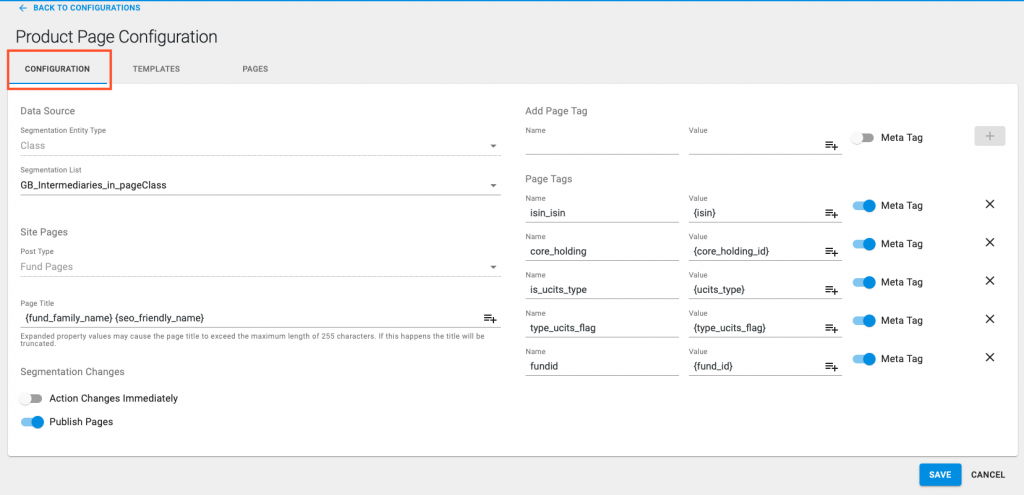
- Data Source
- Segmentation Entity Type – Class or Fund level (your segmentation list will be of this type)
- Segmentation List – select the specific Segmentation list to be used for this configuration
- Site Pages
- Post Type – this is the Engine Custom Post type you made (used to construct the URL slug too)
- Page Title – use any of the current Properties as the Page title as well as static text
Use the Property picker to easily search for and select your Property values.

- Segmentation Changes
- Action Changes Immediately – toggle on to have any changes to segmentation lists affect Pages and Generated pages immediately
- Publish pages – toggle on to publish Pages immediately and automatically by the system (i.e. not in Draft mode)
- Page Tags
If you want to use any of the values produced by the Product page you are generating (and that are available as Properties), you can add them here.
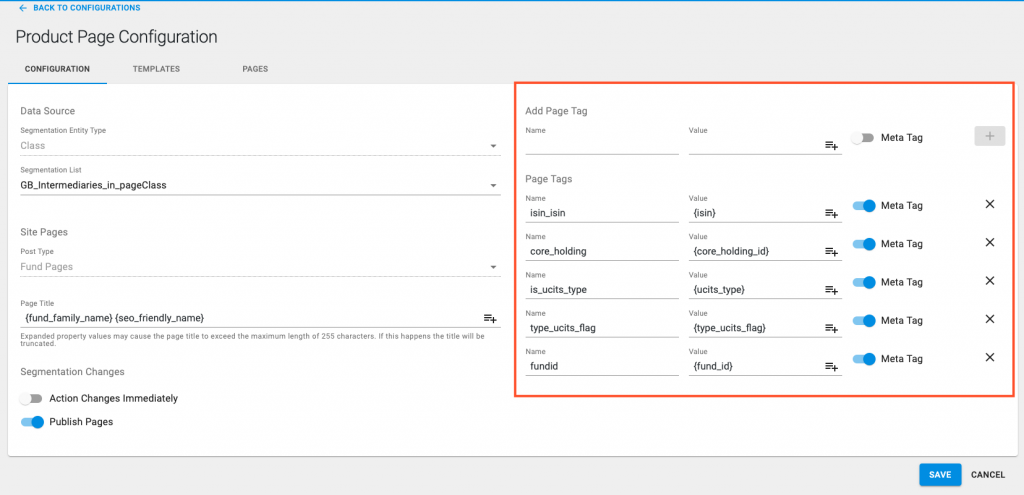
- Name – Enter any name (without special characters) to identify the value you want to use
- Value – Select a Data Dictionary property to use
Use the Property picker to easily search for and select your Property values.
- Meta Tag – If you select this, it will ensure that the value you’ve just created, will also be presented as a Meta element in your Page/Post and HTML. This way you can use it to set up more complex tools using Engine (if you have Meta associated with your Page/Post), as well as for Google Analytics tracking using meta tags (in HTML).
- Click Save after making your selections.
Your basic config is complete, next step is to set up the Templates to be used for your generated Product Pages.
- Complete the section under the TEMPLATES tab.
All sites that contain Product Pages (these can be Fund or Shareclass level pages) will need to be linked to Templates (the Templates provide the look & feel and the Fund Information setup).
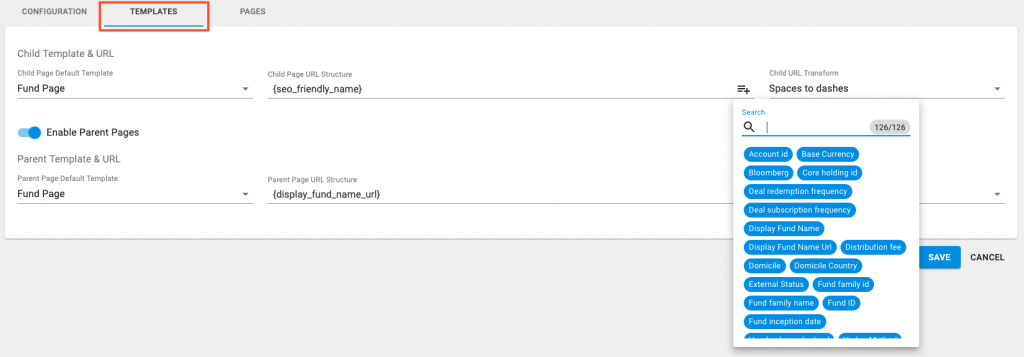
Templates are separated into 2 distinct areas to cover “Child” and “Parent” scenarios:
Child Template & URL
- Child/Parent Page Default Template – Select the Template from a list (will show all Templates accessible for this subsite within DXM).
- Child/Parent Page URL Structure – Select the Property from the App Data which should be used in the URL (eg. myfund-shareclassname-isin01234).
- Child/Parent URL Transform – You can either transform spaces to dashes or underscores. Default is dashes.
Parent Pages vs Child Pages
Child Pages
Every site will have “Child” elements. These are used to reference the last part of the URL in order to identify the page.
E.g.: www.clientname.com/fund/myfund-shareclassname-isin01234
This is typically the level at which Shareclass level pages display specific information about that Shareclass and its unique ISIN (or other identifier) is included in the URL.
Parent Pages
Not all sites will have “Parent” elements as this will impact the way the URL is presented. This adds another layer on top of the last part of the URL as the “Parent” of those pages, usually, the Fund that relates to those shareclasses.
E.g.: www.clientname.com/fund/myfund/shareclassname-isin01234
This is usually used where:
Specific pages that are used for Fundlevel Pages (ie if the user can go to www.clientname.com/fund/myfund/ and view an HTML page there)
Different Templates are used for the Fund level pages and Shareclass level pages
Using Parent Pages
Only toggle Enable Parent Pages on if there is a requirement for two levels of URLs (Parents) in your site.
Note: You will need to adjust the Custom Post type settings within Engine too.
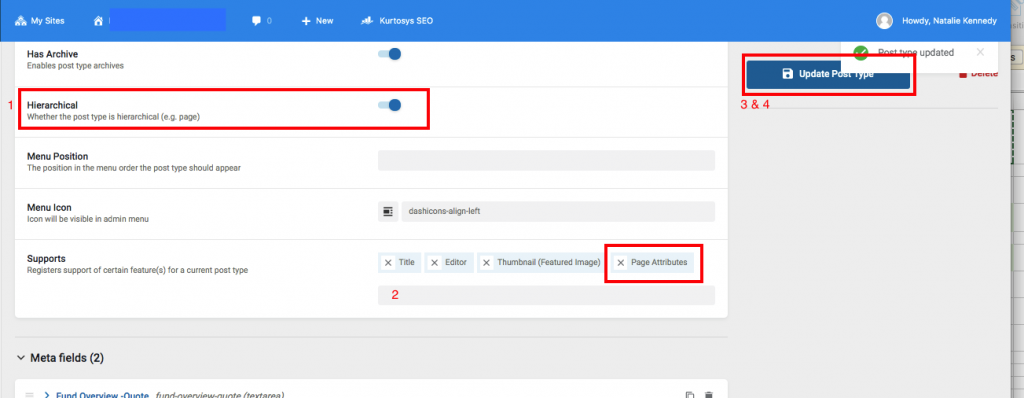
- Toggle Hierarchical Support ON.
- Add Page Attributes to Supports.
- Click Update Post Type to Save.
- Set up or confirm the PAGES tab.
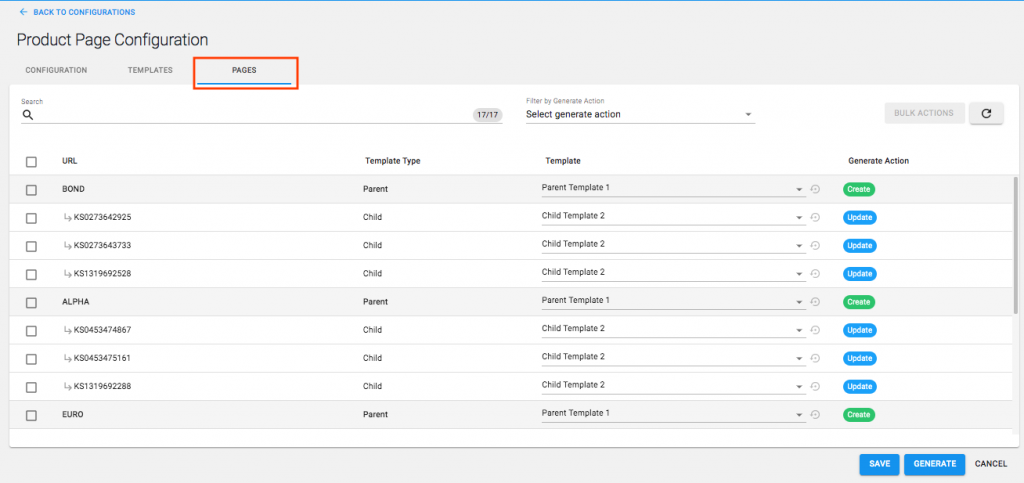
In the Pages section, all possible items (items in your Segmentation list) will be shown according to their Parent-Child relationship (if Parent has been enabled). This screen will allow the user to override certain Pages with another Template.
You can:
- Use the Template dropdown to assign another Template to a specific page (not the default one chosen in the previous Templates section).
- Search using a specific keyword, the filtered list will display. You can apply a specific template to that list by using Bulk Actions.
- Click the refresh icon to view the list of pages according to recent configuration changes.
- Filter by Generate Action to display the current status of the generated pages based on the current configuration.
- Click SAVE to Save your changes.
- Click GENERATE to start the Generation process in order to make all the required Product Pages as per the configurations you have set up.
Managing Configurations
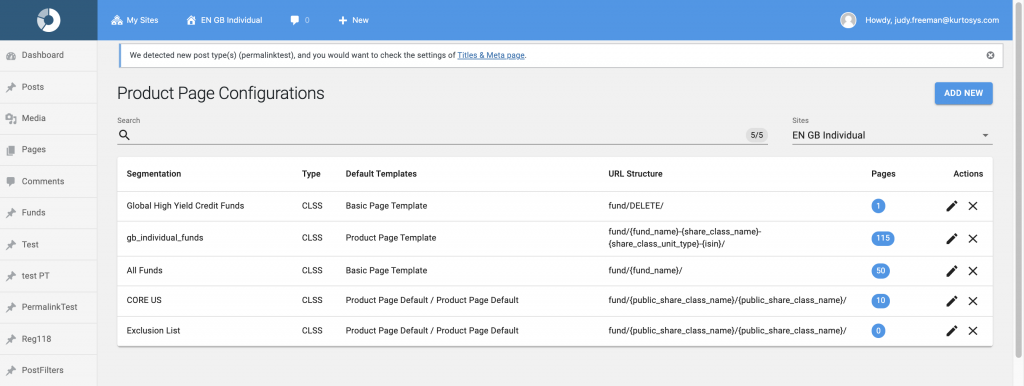
This lists all the configurations for the specific subsite.
Note that this is subsite contextual, so only the specific subsite configurations will show up per subsite.
From this listing, you are able to
Edit an existing configuration
Add a new configuration
Search for a configuration
Go to another subsite to view its Product Page Configurations
Generated Pages
Based on your configuration, your Pages will generate under your Custom Post type; Parent pages, followed by Child pages.
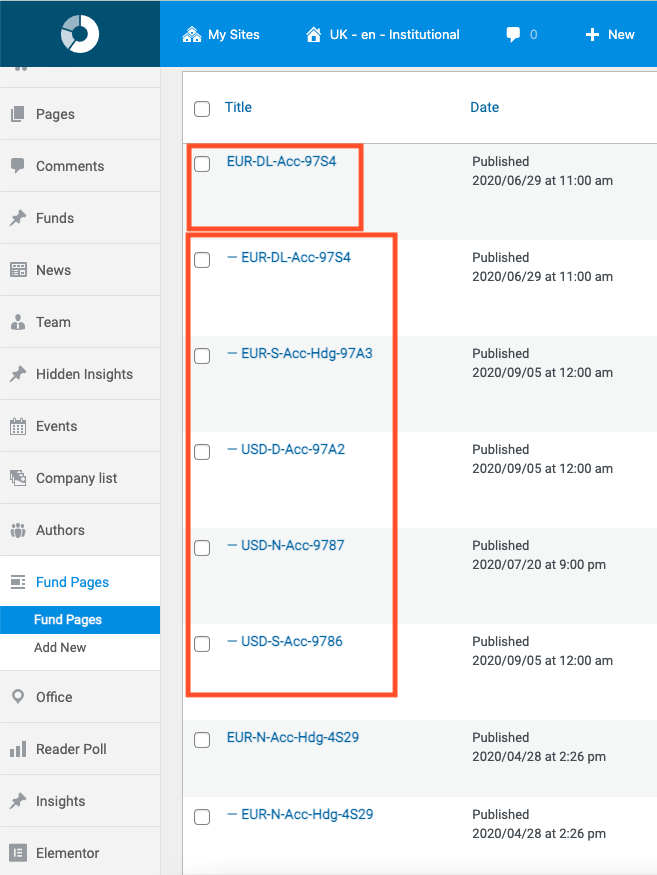
You can view each page here, and it should present with the configured URL, title, template and Meta data.
If you have a hierarchical structure, parent pages will be listed above their corresponding children. They will inherit the property (Page title property) of one of their children.
Publish Automatically
If your pages have been set to Publish Pages toggled ON, they will be available on the URL specified within the template section.
Note: To ensure the Product Pages link through from the Fund Centre as expected, ensure that the URL Structures match up exactly and use the same logic.
Product Page – Manual Generation
If you have made updates to your segmentation lists and the automatic hourly Product Page Generation will be too late, you can manually generate your product pages.
- With the relevant site selected, scroll down to Product Pages Plugin in the menu.
- Click the pencil icon for the applicable segmentation list.
